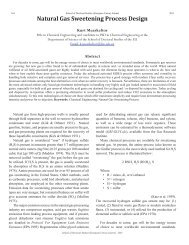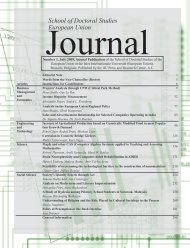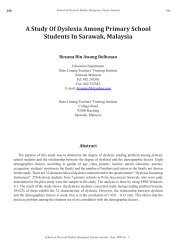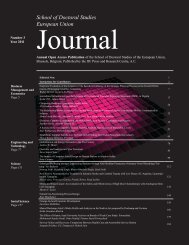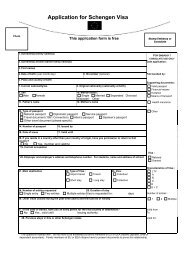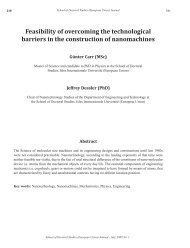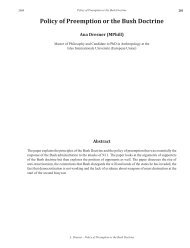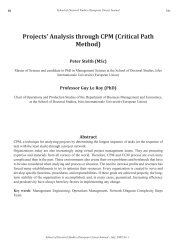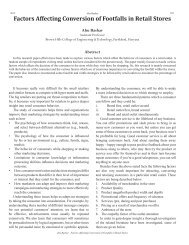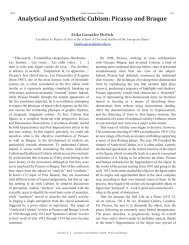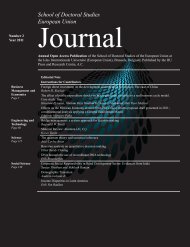Evaluation of Relationship Between Disclosure Quality ... - Iiuedu.eu
Evaluation of Relationship Between Disclosure Quality ... - Iiuedu.eu
Evaluation of Relationship Between Disclosure Quality ... - Iiuedu.eu
Create successful ePaper yourself
Turn your PDF publications into a flip-book with our unique Google optimized e-Paper software.
2012 NasrollaAmoozesh, Zahra Moeinfar and Zahra Mousavi<br />
17<br />
<strong>Evaluation</strong> <strong>of</strong> <strong>Relationship</strong> <strong>Between</strong> <strong>Disclosure</strong> <strong>Quality</strong> and<br />
Corporate Governance <strong>Quality</strong> in Tehran Stock Exchange<br />
Nasrolla Amoozesh<br />
Department <strong>of</strong> Accounting ,Gachsaran Branch , Islamic Azad University , Gachsaran , Iran.<br />
Email: E_amouzesh2011@yahoo.com<br />
Zahra Moeinfar and Zahra Mousavi<br />
Abstract<br />
Present research has been conducted to analyze the relationship between quality <strong>of</strong> corporate governance and disclosure quality.<br />
This research is important because in Iran, very fewer researches have been conducted regarding the effects <strong>of</strong> corporate governance<br />
system quality on the quality <strong>of</strong> information disclosure. Therefore 80 active companies from Tehran stock exchange market have been<br />
chosen during the year 2006 to 2009. Corporate governance quality has been considered as independent variable and disclosure quality<br />
as dependent variable. To test the relationship between these two variables Pearson correlation coefficient and linear regression have<br />
been used. The results show that the company strategic quality has a positive effect on the companies’ disclosure quality, which means<br />
that whenever the methods and works <strong>of</strong> the corporate governance system improved and strengthen there is more accuracy in disclosure<br />
by the companies. Key words: Corporate Governance, <strong>Disclosure</strong>, Concentration Of Ownership, Boardsize.<br />
<strong>Disclosure</strong> in accounting is a vast term and almost<br />
consists <strong>of</strong> all the financial reports. One <strong>of</strong> the initial main<br />
principals <strong>of</strong> accounting is the principal <strong>of</strong> disclosing <strong>of</strong> all<br />
the important realities regarding the financial events and<br />
activities <strong>of</strong> pr<strong>of</strong>it earning units specially LLP Company<br />
(public corporation Company).Adequatesuitable and<br />
complete terms are the terms which are mainly expressed<br />
for disclosure expression. In written accounting and<br />
auditing with regard to understanding <strong>of</strong> each <strong>of</strong> the<br />
writers from disclosure, accordingly adequate disclosure<br />
terms, suitable disclosure or complete disclose have been<br />
mentioned. But the most prevailing view <strong>of</strong> the mentioned<br />
concepts is adequate disclosure which consists <strong>of</strong> minimum<br />
needed disclosure and coordinates with this negative phrase<br />
(financial statements should not be deceiving). Suitable<br />
and complete characteristics are mainly positive concepts.<br />
Suitable disclosure is according to this moral basis which<br />
should face equally with the financial data disclosure.<br />
Complete disclosure consisting <strong>of</strong> all arranged data <strong>of</strong> a<br />
kind which show the financial basis <strong>of</strong>a complete image<br />
<strong>of</strong> financial activities and events <strong>of</strong> pr<strong>of</strong>it making unit.<br />
Even though it is necessary for the financial statement to be<br />
presented in complete way, but it should not contain data<br />
more than what is needed or with less importance, because<br />
there is a chance <strong>of</strong> users consideration goes towards<br />
the less important data and as a result important events<br />
and activities be neglected(Aaliwar 1386). <strong>Disclosure</strong><br />
causes increase in transparency and the market is a main<br />
mechanism for decreasing information symmetry between<br />
participants in the financial market( Blake& Loo 2006).<br />
It also helps the shareholders and other participants in the<br />
financial market to arrange their activities in a suitable way.<br />
With suitable disclosure <strong>of</strong> information,investors can buy<br />
and sell shares in a correct way and have more control over<br />
the company (Kinda 1999).<br />
Corporate Governance Mechanisms effects the disclosed<br />
information by company for the shareholders and there is<br />
possibility <strong>of</strong> non complete and non suitable disclosure<br />
<strong>of</strong> information and disclosure <strong>of</strong> less credit data will be<br />
reduced (Katagortnam and colleagues 2007). Researchshow<br />
that if board <strong>of</strong> directorssupervises on the management<br />
effectively, quality and efficiency <strong>of</strong> published databy<br />
the management will increase(Karamono& Nikos 2005).<br />
Corporate Governance Mechanisms with the better quality,<br />
increases the quality and quantity <strong>of</strong> disclosed information<br />
by the company and causes reduction <strong>of</strong> asymmetric data (<br />
Rehimian and colleague 1388).<br />
Therefore the following research has been clarified after<br />
analysis <strong>of</strong> the effect <strong>of</strong> quality <strong>of</strong> corporate governance<br />
system on the quality <strong>of</strong> company’s disclosure. Therefore<br />
with the use <strong>of</strong> solidarity test and linear regression,<br />
direction and the amount <strong>of</strong> the effect are clarified and<br />
meaningfulness <strong>of</strong> the coefficient obtainedhas been tested.<br />
In this regard first the theatrical basis, research back ground<br />
Amoozesh N., Moeinfar Z., Mousavi Z. - <strong>Evaluation</strong> <strong>of</strong> <strong>Relationship</strong> <strong>Between</strong> <strong>Disclosure</strong> <strong>Quality</strong> and Corporate Governance <strong>Quality</strong> in Tehran Stock Exchange
18 School <strong>of</strong> Doctoral Studies (European Union) Journal 2012<br />
such as theoretical basis according to the definitions, views<br />
and hypothesis <strong>of</strong> the subject and practical background <strong>of</strong><br />
the research and views and results <strong>of</strong> different researchers<br />
have been <strong>of</strong>fered, then in the method <strong>of</strong> research section,<br />
the type <strong>of</strong> research, research variables, statistical society,<br />
its method <strong>of</strong> choosing and method <strong>of</strong> its use for data<br />
analysis will be introduced and then research hypothesis<br />
and research findings will be presented. At the end result <strong>of</strong><br />
the research and suggestions obtained will be <strong>of</strong>fered.<br />
Theoretical Framework<br />
Different elements can affect the amount and disclosure<br />
quality <strong>of</strong> the companies. One <strong>of</strong> these elementsis corporate<br />
governance system and regulatory mechanisms. With<br />
accurate use <strong>of</strong> this corporate governance regulation<br />
internal control system and specially accounting committee<br />
inspection cause disclosure <strong>of</strong> data and avoid volatility <strong>of</strong><br />
estimated pr<strong>of</strong>its and interference in the prices. Therefore if<br />
the corporate governance mechanisms supervision acts in<br />
an effective and efficient way, this system can be effective<br />
on the amount and quality <strong>of</strong> disclosed date by the company<br />
(Davani 1385).<br />
volubility and effectiveness <strong>of</strong> disclosed datadepends on<br />
conditions such as financial constructive type or company’s<br />
ownership body ( Kanda 1999) when the ownership <strong>of</strong> a<br />
company is completely at the authority <strong>of</strong> some limited<br />
people which usually it is expected that they are not able<br />
to answer the questions <strong>of</strong> other investors and the public<br />
because the controller shareholders are usually able to<br />
obtain their needed data through other methods (Karmeer<br />
2005). Also at the side <strong>of</strong> agents expenses regarding the<br />
separation <strong>of</strong> ownership from control will increase,minority<br />
shareholders have more motivation for supervising the<br />
people inside the company and therefore demand for<br />
company’s data disclosure increases (Golb 2000). Since<br />
ownership dispersion causes increase in the expenses,<br />
therefore it can improve the disclosure quality.<br />
On the other hand institutional investors are the main<br />
providers <strong>of</strong> fund in the financial market. They are usually<br />
owners <strong>of</strong> a high portion <strong>of</strong> companies’ shares and have good<br />
experiences and are usually pr<strong>of</strong>essionals. Their activities<br />
can cause protection <strong>of</strong> the rights <strong>of</strong> investors and cause<br />
wealth for them. This group <strong>of</strong> investors needscomplete<br />
disclosure which causes the risk <strong>of</strong> the company and<br />
the element <strong>of</strong> their success to be able to make a better<br />
estimation <strong>of</strong> cash distribution in the future (Bin Ali 2006).<br />
Increase in the institutional ownership causes increase<br />
in the control on the company’s management which this<br />
may cause reduction <strong>of</strong> non disclosure <strong>of</strong> information by<br />
management (Chaoo and Gery 2002).<br />
In casewhich board members are many in numberswhich<br />
consist <strong>of</strong> skilled managers with different experience,<br />
the efficiency <strong>of</strong> data transfer can improve; this means that<br />
the companies with small board <strong>of</strong> directors will disclose<br />
less data in their financial statementscompare to the other<br />
companies (AlshiMiri 2004). Therefore we suggest that<br />
there is a positive relation between board <strong>of</strong> directors and<br />
disclosing. In the other words the number <strong>of</strong> board members<br />
<strong>of</strong> the company can affect the information disclosure. And<br />
therefore the disclosure is a strategic decision which is being<br />
adopted by the board <strong>of</strong> directors (chen and Jaji 2000).<br />
Also experimental evidence shows that when the<br />
number <strong>of</strong> management board is smaller, the quality <strong>of</strong> their<br />
supervision will improve (Bermak 1996). Ratio <strong>of</strong> nonbound<br />
member in the management board is a controlled<br />
mechanism which shows their independence.Non-bound<br />
members can be useful on the companies for disclosing<br />
more data (Ang& Mark 2003).<br />
Therefore it can be understood that management board<br />
independently can affect the disclosure quality <strong>of</strong> the<br />
companies.<br />
Generally it can be proved that corporate governance<br />
system mechanism( such as ownership centralization,<br />
institutional investors and the size <strong>of</strong> management board)<br />
give this confidence to the minority investors that the data<br />
will give the financial condition, company’s functioning<br />
and value clearly and protect their wealth against misuse <strong>of</strong><br />
the executive managementand majority investors.<br />
Considering the above mentioned, the question <strong>of</strong><br />
the research can be brought up as follows: can corporate<br />
governance system affect the data disclosure quality<br />
Research Background<br />
The most important researches conducted on this subject<br />
are presented as follows:<br />
Van Mohammad &Solang(2010) conducted a research<br />
with the title <strong>of</strong> “corporate governance mechanism and<br />
disclosure in Malaysia”. Their aim was to analyze the<br />
effectiveness <strong>of</strong> corporate governance mechanism on the<br />
amount <strong>of</strong> company’s disclosure. The results obtained show<br />
that the company with family members in the management<br />
board have lower level <strong>of</strong> disclosure in comparison to other<br />
countries.<br />
Loo and Chan 2009 analyzed the effective elements<br />
on the active companies in the Taiwan stock exchange<br />
market. They conducted this research with the use <strong>of</strong> 389<br />
School <strong>of</strong> Doctoral Studies (European Union) Journal - 2012
2012 NasrollaAmoozesh, Zahra Moeinfar and Zahra Mousavi<br />
19<br />
informative records during the year 2003. Their research<br />
show that percentage <strong>of</strong> institutional ownership and<br />
financial institutions, type <strong>of</strong> industry, size <strong>of</strong> the company<br />
and percentage <strong>of</strong> share under the control <strong>of</strong> institutional<br />
shareholders have considerable affect on the companies’<br />
information disclosure.<br />
Bin Ali (2006) in his research analyzed the relation<br />
between disclosure quality and corporate governance.<br />
He conducted this research with the use <strong>of</strong> some active<br />
companies in France stock exchange. The results <strong>of</strong>research<br />
showed that the companies with weak disclosure <strong>of</strong> quality<br />
have higher concentration <strong>of</strong> ownership.Also companies<br />
with suitable quality disclosure have higher percentage<br />
than those who are participating independently in the<br />
management board and not working as a family. Generally<br />
the results <strong>of</strong> hypothesis test in this research show that there<br />
is a negative relation between disclosure quality and family<br />
control and ownership concentration, but there is a positive<br />
meaningful relation between quality disclosure and buying<br />
share option <strong>of</strong> executive management.<br />
Boshi and Noaeh (2000) after their research got the<br />
results that there is a positive meaningful relation between<br />
the high percentage <strong>of</strong> institutional shareholding ownership<br />
and disclosure quality <strong>of</strong> the companies. They found out<br />
that institutional investors with high shares prefer higher<br />
quality <strong>of</strong> disclosure as a method for reducing other<br />
institutional expenses. Golb( 2000) used a sample <strong>of</strong> 3219<br />
from active companies in the United States <strong>of</strong> America<br />
and analyzed it in period <strong>of</strong> 1981 to 1993. His aim is to<br />
analyze the relation between ownership concentration<br />
and disclosure in the country. Where ownership has been<br />
dispersed widely, he got the result that ownership dispersion,<br />
increase people’s demand out <strong>of</strong> company for obtaining<br />
information and therefore company’s data disclosure will<br />
increase. Generally, controlling shareholders have better<br />
motivation and more opportunities for supervision on the<br />
other shareholders.<br />
Kemalian and colleagues (1389) in their research found<br />
out the most important effective elements on the degree <strong>of</strong><br />
data disclosure <strong>of</strong> the companies accepted in Tehran stock<br />
exchange market. Their research with regard to the degree<br />
which stock market has presented to them due to their<br />
time consciousness and its reliability on companies data<br />
disclosure have been published and wanted to recognize<br />
the elements effective on the degree <strong>of</strong> data disclosure.<br />
They use samples consisting <strong>of</strong> 520 years-companies<br />
from the financial year <strong>of</strong> 85, 86 and 87 elements which<br />
had the most effect on the degree <strong>of</strong> data disclosure. These<br />
elements are consisted <strong>of</strong> quality <strong>of</strong> auditing organization<br />
<strong>of</strong> the company, return on asset, debt ratio and management<br />
board being bound or non-bound. The result <strong>of</strong> their<br />
research show that analysis <strong>of</strong> above elements can help in<br />
recognition <strong>of</strong> company’s clear information as an informal<br />
system in decision making <strong>of</strong> the investors.<br />
Research Plan<br />
Even though the corporate governance quality<br />
calculation index consisted <strong>of</strong> four groups, but the final<br />
point <strong>of</strong> this variable is in the form <strong>of</strong> a unit. Therefore to<br />
answer the research questions a main hypothesis has been<br />
codified which this hypothesis is tested in the statistical<br />
society member companies. This hypothesis has been<br />
mentioned as follows:<br />
There is a meaningful relation between quality <strong>of</strong><br />
information disclosure and corporate governance system<br />
quality.<br />
Definition <strong>of</strong> Variables<br />
Dependent variable: in this research dependent variable<br />
is the quality <strong>of</strong> companies’ disclosure. <strong>Quality</strong> <strong>of</strong> disclosure<br />
is dependent on many elements which Tehran stock<br />
exchange has calculated the total companies’ activities <strong>of</strong><br />
quality disclosure during the past years and presented them.<br />
In this research the calculated marks <strong>of</strong> this company has<br />
been used as disclosure quality evaluation. This research<br />
reflects the stock market evaluation score regarding<br />
the amount <strong>of</strong> awareness <strong>of</strong> company’s disclosure. The<br />
mentioned scores according to average weighing score<br />
in being on time and reliability <strong>of</strong> data disclosure. Data<br />
evaluated according to the laws <strong>of</strong> data disclosure in the<br />
stock market consisting <strong>of</strong> matters such as annual financial<br />
list, accounting financial statements <strong>of</strong> midterm and income<br />
forecasting <strong>of</strong> each share at the period <strong>of</strong> 3, 6, 9, and 12<br />
months ( Nouroosh&Hossiani 1388).<br />
B. Independent Variable:<br />
Independent variable: in this research corporate rule<br />
<strong>of</strong> quality is calculated according to index presented by<br />
Desilverya (2007) which consists <strong>of</strong> 4 main sections:<br />
capability <strong>of</strong> accessing to data, data consistence, and<br />
construction <strong>of</strong> management board, and control <strong>of</strong> this<br />
index which is a check list <strong>of</strong> 20 question in relation to<br />
corporate governance system and each system has one<br />
point. If the answer the questions are positive, company<br />
gets one point but if it is negative the answer to the question<br />
Amoozesh N., Moeinfar Z., Mousavi Z. - <strong>Evaluation</strong> <strong>of</strong> <strong>Relationship</strong> <strong>Between</strong> <strong>Disclosure</strong> <strong>Quality</strong> and Corporate Governance <strong>Quality</strong> in Tehran Stock Exchange
20 School <strong>of</strong> Doctoral Studies (European Union) Journal 2012<br />
does not obtain any point.At the end the points obtained for<br />
each company will be summed and the number obtained<br />
show the corporate governance <strong>of</strong> the company. If the score<br />
<strong>of</strong> the corporate ruling quality is 15 to 20, the ruling <strong>of</strong> that<br />
company will be considered strong. And if it is 9 to 15 the<br />
company is about average and if the point is less than 9, the<br />
ruling <strong>of</strong> that company will be considered weak and this<br />
index will be mentioned in the article attached.<br />
Statistical Society and Sample<br />
Statistical society <strong>of</strong> this research was companies<br />
accepted in Tehran stock exchange. The research has been<br />
conducted during the years 1385-87. From this society,<br />
sample companies with the following conditions were<br />
chosen as samples:<br />
• Which are not among the investing companies or<br />
financial mediated companies ,holding, banks or leasing<br />
• To create comparison, the financial year ending will be<br />
fixed on 29thEsfand.<br />
• The financial data <strong>of</strong> the companies should be available<br />
during the study.<br />
• The companies share transaction should be conducted<br />
continuously in Tehran stock exchange and there should<br />
not be a stop <strong>of</strong> more than one month.<br />
According to the conditions mentioned above, 80<br />
companies had these conditions during the years 1385 to<br />
87 and have been chosen as statistical samples.<br />
Analysis Method<br />
Of course the disclosure quality in any <strong>of</strong> the sample<br />
companies will be summed and then with the use <strong>of</strong> notes<br />
together with the financial statements, data regarding the<br />
corporate governance system have been collected. Then<br />
with the use <strong>of</strong> these information and completion <strong>of</strong> check<br />
list about the corporate quality scores is counted as member<br />
<strong>of</strong> the companies. These activities have been done with<br />
EXCELL s<strong>of</strong>tware and then the use <strong>of</strong> SPSS s<strong>of</strong>tware this<br />
hypothesis test will be done.<br />
The method <strong>of</strong> present research is from the type <strong>of</strong><br />
solidarity. Solidarity research consists <strong>of</strong> researches which<br />
try to create relation between different variables with<br />
solidarity coefficient. In this type <strong>of</strong> research, coefficient<br />
determination (coefficient square) is a criterion which<br />
explains the relation intensity between independent<br />
variable and dependent variable. The amount <strong>of</strong> this<br />
coefficient shows the percentage <strong>of</strong> dependent variables<br />
by independent variables. In the other words solidarity<br />
analysis is a statistical tool which a displacement from one<br />
variable to another variable has been measured linearly<br />
is being discussed in two criteria which are coefficient<br />
determination and solidarity coefficient.<br />
Coefficient determination is the most important criterion<br />
which through it the relation between two variables X and<br />
Y is explained. Coefficient determination shows the ability<br />
and capability <strong>of</strong> the regression equation in forecasting<br />
dependent variables changes according to independent<br />
variables changes and its amount is within zero and one.<br />
(0< R 2 < 1).<br />
Solidarity coefficient (r).<br />
We take squar root from coefficient determination the<br />
amount obtained is called solidarity coefficient and show<br />
it with “r”:<br />
r = r2<br />
Intensive solidarity coefficient relation and also the type<br />
<strong>of</strong> relation show direct or reverse.<br />
In case there is a random sample <strong>of</strong> n number from<br />
variables (x,y) in this case obtaining the solidarity<br />
coefficient in the p society as follows:<br />
P = R =<br />
∑<br />
∑(<br />
( X − X<br />
X − X<br />
−<br />
)<br />
−<br />
2<br />
)( Y −Y<br />
∑<br />
−<br />
)<br />
Y −Y<br />
Which its amount is always between -1 and 1 (-1< r0 the linear relation between x,y is direct.<br />
If r
2012 NasrollaAmoozesh, Zahra Moeinfar and Zahra Mousavi<br />
21<br />
H0 rejected and H1 is accepted == if pvalue < α ( test is<br />
meaningful).<br />
Findings <strong>of</strong> the Research<br />
Descriptive statistics:<br />
In this research quality <strong>of</strong> corporate governance system<br />
means concentration <strong>of</strong> ownership and its relation with<br />
company’s data disclosure quality have been analyzed. In<br />
table No. 1 consisting <strong>of</strong> descriptive statistic variables have<br />
been tested.<br />
Table 1- descriptive statistic data <strong>of</strong> the research<br />
Since the meaningful level has been calculated according<br />
to what is mentioned above if it is less than 0/05, sig=0/001)<br />
statistical findings show that there is a meaningful relation<br />
between ownership concentration and rate <strong>of</strong> return <strong>of</strong><br />
the finance. In the other words the research hypothesis<br />
conformed and errors are rejected. And therefore it can be<br />
said that in a level <strong>of</strong> confidence <strong>of</strong> 95% there is a positive<br />
and meaningful relation between disclosure quality and<br />
corporate governance system quality.<br />
Table below shows the regression results and “t”<br />
statistics <strong>of</strong> this hypothesis:<br />
Table 3: Regression<br />
Variables<br />
Number <strong>of</strong><br />
Observation<br />
Minimum<br />
Max<br />
Average<br />
Standard<br />
Deviation<br />
<strong>Disclosure</strong> <strong>Quality</strong> 240 2 100 54/32 22/98<br />
Corporate Governance System 240 11 16 13/46 1/31<br />
The information mentioned in the table 1 show that the<br />
disclosure quality average in these sample companies and<br />
during the time <strong>of</strong> analysis has been 54/32. It also can be<br />
found out that the min points for disclosure quality in the<br />
companies chosen obtained 3 points which is absolutely bad<br />
point for disclosure <strong>of</strong> a company. Also average quality <strong>of</strong><br />
corporate governance system for these companies is 13/46.<br />
Considering min and max point <strong>of</strong> corporate governance<br />
at the amount <strong>of</strong> 11 and 16 can be proved that governance<br />
system laws have been followed by the companies’ very<br />
much and it has been suitable. An important point is that in<br />
this table there is dispersion <strong>of</strong> disclosed quality variable.<br />
At the last raw which belong to standard deviation the<br />
research variables show these claim.<br />
Results <strong>of</strong> Hypothesis Analysis<br />
As shown in the below table solidarity coefficient<br />
between the two disclosure quality variable and corporate<br />
governance system quality is equal to /210 (r=0/210).<br />
Variable<br />
Table 2: solidarity test<br />
Solidarity<br />
Coefficient<br />
Determinant<br />
Coefficient<br />
Adjusted<br />
Determinant<br />
Coefficient<br />
Meaningful<br />
Level<br />
Corporate governance system 0/21 0.044 0/040 0/001<br />
Model<br />
Beta<br />
Standard<br />
Error<br />
T Statistic<br />
Meaningful<br />
Level<br />
Stable amount 12/809 /213 60/114 /000<br />
<strong>Disclosure</strong> quality /012 /004 3/381 /001<br />
The results from the above table show that intensity<br />
<strong>of</strong> relation between disclosure quality and corporate<br />
governance quality is equal to 0/040, Which means 0/040<br />
<strong>of</strong> disclosure <strong>of</strong> the variable data <strong>of</strong> the company is done<br />
by the corporate governance quality and about 96% <strong>of</strong> it is<br />
because <strong>of</strong> other variables which have not been analyzed in<br />
this research.<br />
Conclusion<br />
In this research corporate governance system quality<br />
regarding the disclosure quality <strong>of</strong> data in a period <strong>of</strong> 3<br />
years has been analyzed. The aim <strong>of</strong> this research is to<br />
analyze the effect <strong>of</strong> corporate governance quality on<br />
the disclosure quality <strong>of</strong> information. This research is<br />
important because in Iran, there islittle research about the<br />
determination <strong>of</strong> relation between corporate governance<br />
quality and disclosure quality <strong>of</strong> data has been conducted.<br />
In general findings <strong>of</strong> the research are evidence regarding<br />
the positive effect <strong>of</strong> corporate governance system quality<br />
on the disclosure quality <strong>of</strong> data. It means that findings <strong>of</strong><br />
this research show a positive relation between these two<br />
variables when the company’s leadership practice has<br />
been invigorated and run with high quality. The quality<br />
<strong>of</strong> disclosure by these companies is also increased. These<br />
findings are match with the researchers conducted by Ven<br />
Mohammad and SouLoung (2010), Lou and Chen (2009),<br />
Bin Ali (2006), Boshi and Noa ( 2000), and Kemalian<br />
Amoozesh N., Moeinfar Z., Mousavi Z. - <strong>Evaluation</strong> <strong>of</strong> <strong>Relationship</strong> <strong>Between</strong> <strong>Disclosure</strong> <strong>Quality</strong> and Corporate Governance <strong>Quality</strong> in Tehran Stock Exchange
22 School <strong>of</strong> Doctoral Studies (European Union) Journal 2012<br />
(1389). Considering these results it can be proved that<br />
companies with corporate governance system mechanism<br />
can be operated in a suitable way that in ratio to the other<br />
companies and data disclosure can be observed better.<br />
When disclosure quality <strong>of</strong> data have been improved by the<br />
company this causes more attraction <strong>of</strong> the financers and<br />
finally causes more investment with longer term investing.<br />
Increase in the absorption <strong>of</strong> investment by the companies<br />
cause reduction in the company’s financial expenses and<br />
therefore increase in the price <strong>of</strong> shares.<br />
Therefore considering the results <strong>of</strong> this research it<br />
can be proved that suitable establishment <strong>of</strong> corporate<br />
governance mechanism in the companies because clear<br />
increase and therefore reduction <strong>of</strong> data asymmetry.<br />
Therefore it is suggested to the stock exchange market<br />
to force the companies to model their annual reports<br />
according to the corporate governance model and explain<br />
their mechanisms. Also with regard to the results <strong>of</strong> this<br />
research it is suggested that a unit scope should be proposed<br />
for corporate governance quality by the stock exchange<br />
and the companies have the duty <strong>of</strong> reporting this number<br />
in the note with its financial list. Future researchers can<br />
execute this corporate governance quality with the use <strong>of</strong><br />
calculative index. Also in the future research the effect <strong>of</strong><br />
other financial variables and companies activities such as<br />
pr<strong>of</strong>it earning, capital construction and other data disclosure<br />
quality can be analyzed.<br />
Acknowledgement<br />
This research has been obtained from Islamic Azad<br />
University research <strong>of</strong> Gachsaran Branch.<br />
References<br />
Aalivae Aziz, disclosing in financial reports, No<br />
68 research center for accounting and editing<br />
publication.<br />
Ben Ali , C ., He , Z . , Trablesi , S . (2007) . Unrevealing<br />
the relation between <strong>Disclosure</strong> <strong>Quality</strong> , Ownership<br />
Structure and Stock Liquidity .<br />
Bleck , Alexander ., Liu , Xuewen . (2007 ) . Market<br />
Accounting Regim . Journal <strong>of</strong> Accounting<br />
Research , vol 45 . No. 2 , pp.229-256 .<br />
Bushee , B , Noe , C . (2000) . Corporate <strong>Disclosure</strong><br />
Practices , institutional investors and stock return<br />
volatility . Journal <strong>of</strong> Accounting Research , vol 38,<br />
pp: 71-202 .<br />
Ch<strong>eu</strong>ng , S.Y., Connelly, J.T., Limpaphapom,P., Zhou,<br />
L. (2006 ). Determinants <strong>of</strong> corporate disclosure<br />
and transparency: Evidence from Hong Kong and<br />
Thailand.<br />
Gelb, D.S. (2000). Managerial Ownership and<br />
Accounting <strong>Disclosure</strong>: An Empirical study,<br />
Review <strong>of</strong> Quantitative Finance and Accounting,<br />
vol 15 , pp. 169-185.<br />
Hsiu, J.F. (2006). Effect <strong>of</strong> financial information<br />
transparency on investor behavior in Taiwan Stock<br />
Market. Proquest Database, 16(3), pp.6-22.<br />
Kanagartnamkiridaran, lobo Gerald j., whalendennisj.<br />
does good corporate governance reduse<br />
information asymmeety around quarterly earnings<br />
announcements journal <strong>of</strong> accounting and public<br />
policy 2007: 26 ( 4 ): 497 – 522 .<br />
Kanda,Hideki.(1999). “<strong>Disclosure</strong> and Corporate<br />
Governance: A Japanese perspective. “conference<br />
on corporate governance in Asia: A comparative<br />
perspective.<br />
KaramanouIrene, vafeasnikos. the association<br />
between corporate boards, audit committees, and<br />
management earnings forecasts: an empirical<br />
analysis. journal <strong>of</strong> accounting research 2005: 43:<br />
453 – 486.<br />
Kemalian Amin Reza, NikNafs Ali Akbar,<br />
Afsharizadehomid and Gholamali pour Reza, the<br />
most important elements effective on the degree<br />
<strong>of</strong> company’s disclosure date from the companies<br />
accepted in Tehran Stock Exchange market with<br />
journal <strong>of</strong> stock exchange market, No. 11, Fall 89,<br />
p. 144-125.<br />
Lu, c.l., and chen, t.c. ( 2009 ). a study <strong>of</strong> applying data<br />
mining approach to the information disclosure for<br />
tiwan‘s stock market investors .expert system with<br />
applications, 36 ( 2 ), 3536 – 3542.<br />
NoroshIraj and HossianiSayed Ali (1388. Analysis<br />
<strong>of</strong> relation between disclosure quality ( being on<br />
time qand dependable) and pr<strong>of</strong>it management.<br />
Accounting and editing Analysis. 16th period, No.<br />
55, Spring 1388. Page 117, 134.<br />
Rehimian, Nezamoldin. SalehNejadseyed Hassan,<br />
Saleki Ali: relation between some <strong>of</strong> the mechanisms<br />
<strong>of</strong> company rule and data asymmetrism in the<br />
companies accepted in Tehran stock Exchange<br />
Market, accounting and editing analysis 16 period,<br />
No. 58 winter 1388 page 71-86.<br />
School <strong>of</strong> Doctoral Studies (European Union) Journal - 2012
2012 23<br />
Appendix<br />
Corporate Governance <strong>Quality</strong> Checklist<br />
1. Is the company’s report avialabe in the internet<br />
Question Yes No<br />
2. Is the web site consist documents <strong>of</strong> corporate governance such as ruling guidance, model <strong>of</strong> ruling<br />
explanation Etc<br />
3. Is the company web site aviable for analysts with useful financial date<br />
4. Has the company website planned a part for investor<br />
5. Isn’t it necessary to contact company for more information<br />
6. Are the corporate governance model and its methos explained for annual reports<br />
7. Are the financial list prepared according to accounting method<br />
8. Is the annual report <strong>of</strong> the company or web site consist <strong>of</strong> section for estimation <strong>of</strong> financial return (ROA.<br />
ROE)<br />
9. Did the annual report or other documents <strong>of</strong> the company <strong>of</strong>fers the value-added<br />
10. Are the management board and director <strong>of</strong> the company same<br />
11. Are the management members <strong>of</strong> the company between 5 to 9<br />
12. Are more than 80% <strong>of</strong> the management members from out side the company<br />
13. Are more than 80% <strong>of</strong> management members from out side the company ( non-bound members)<br />
14. Has the company any agreement with the shareholder<br />
15. Is the company producing only ordinary shares<br />
16. Is the premium share less than 50% <strong>of</strong> published shares<br />
17. Are the controlling shareholders owners <strong>of</strong> less than 70% <strong>of</strong> the whole ordinary share <strong>of</strong> the company<br />
18. Are the differences between least controlling shareholders ( percentage <strong>of</strong> share which has the right for<br />
voting (% <strong>of</strong> total share is less than 23%)<br />
19. Did the company give any voluntary rights to any premium shareholder<br />
20. Are the annual reports or any other documents reveal executive manager reward<br />
Total:



